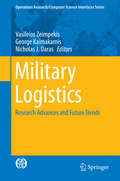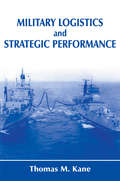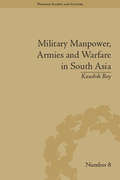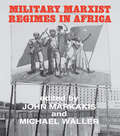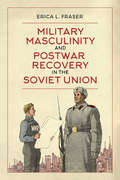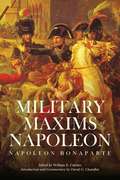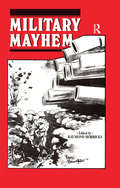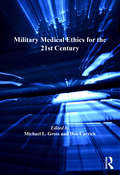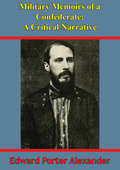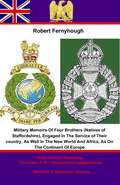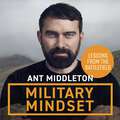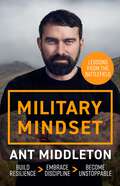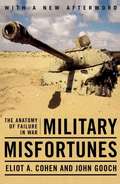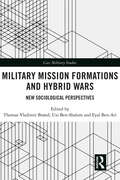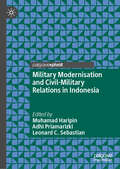- Table View
- List View
Military Logistics
by Vasileios Zeimpekis George Kaimakamis Nicholas J. DarasThis book highlights recent advances in the development of effective modeling and solution approaches to enhance the performance of military logistics. It seeks to further research in global defense-related topics, including military operations, governmental operations and security, as well as nation support. Additionally its purpose is to promote the global exchange of information and ideas amongst developers and users of military operations research tools and techniques. Over the course of its nine chapters, this edited volume addresses significant issues in military logistics including: a) Restructuring processes via OR methods aimed at improving the efficiency and effectiveness of the military logistics, b) Sense-and-Respond logistics prediction and coordination techniques that provide competitive advantage, spanning the full range of military operations across the strategic, operational and tactical levels of war, c) Procurement and auctioning, d) Inventory and stock control theories and applications, e) Military transport and logistical equipment, and, f) Maintenance, repair and overhaul on operational capability in general and equipment availability. The book aims to bridge the gap between the abundant literature on commercial logistics and its scarce defense & combat counterpart. This collection of useful insights into new trends and research will offer an ideal reference for practitioners and army related personnel interested in integrating scientific rigor to improve logistics management within defense organizations & agencies. Ultimately this book should provide a relevant platform for the latest contributions of operations management, operations research, and computational intelligence towards the enhancement of military logistics.
Military Logistics and Strategic Performance (Strategy And History Ser.)
by Thomas M. KaneThis work argues that logistics in warfare is crucial to achieving strategic success. The author identifies logistical capabilities as an arbiter of opportunity, which plays a critical role in determining which side will hold the strategic iniative in war. Armies which have secured reliable resources of supply have a great advantage in determining the time and manner in which engagements take place. Often, they can fight in ways their opponents cannot. The author illustrates this point with case studies of British logistics during the Burma campaign in the World War II, American logistical innovations during the Pacific War, Communist supply methods during the American phase of the Vietnam War and the competing logistical systems of both NATO and Warsaw Pact conventional forces during the Cold War.
Military Low-Flying in the UK: The Men Who Fly and the Skill of the Photograhers that Capture Them
by Michael LeekThe UK has some of the most dramatic landscapes for NATO pilots to exercise the increasingly important military art of high-speed low flying. It also offers splendid opportunities for photography of close-up dramatic shots taken from the hillsides and mountains of Wales, Scotland and other steep terrain within the UK. Pilots training for operations in Afghanistan, Iraq and other potential war zones, learn their skills flying through the valleys of the UK at near subsonic speed. For the legions of enthusiastic aviation photographers, thousands of whom can be seen at air shows, it provides ideal viewpoints.This book contains firsthand accounts from the pilots and expert advice for the photographer, together with stunning close-up color photos of the aircraft flying at eye-level and sometimes below the camera. It has the full support of the Royal Air Force and articles by the leading photographers in this field.
Military Low-Level Flying From F-4 Phantom to F-35 Lightning II: A Pictorial Display of Low Flying in Cumbria and Beyond
by Scott Rathbone"The author and his friends have been able to capture some truly remarkable images of modern military aircraft engaged in this activity - everything from a glider, to the massive and strange A400 Atlas, to Lockheed Martin F-35s." — Air ClassicsThe United Kingdom has some of the most dramatic landscapes that can be used by pilots to train in the vital skill of low flying. Aircrew preparing for operations in Afghanistan, Iraq and other potential war zones frequently hone their skills flying through the valleys of the UK, sometimes at near subsonic speed. In Cumbria, as well as other major training areas within the United Kingdom Low Flying System, such as parts of Scotland and the world-famous Mach Loop in Wales, pilots can be seen on an almost daily basis sharpening their skills as they weave their aircraft, from basic trainers to the latest high-tech fighters, between the hillsides. As a result, these locations offer remarkable opportunities for photographers to capture close-up and dramatic shots. These sights have captured the imagination of many photographers who have devoted many hours and displayed great patience in waiting to snap dynamic images on camera, the majority of these since the birth of digital photography. while photographs of military low flying prior to the digital age are rare, in the pages of this book the author presents a selection of images to showcase just how things have developed since the 1980s – particularly focusing on the action to be seen over the hills and valleys of Cumbria and the Lake District which, since 1979, has been a major area in the training of military pilots. In these pages are amazing shots of scores of different types of aircraft, from Jet Provosts, Buccaneers and Hawks through to F4 Phantoms, A-10 Thunderbolts, Tornadoes, Typhoons, and F-35 Lightnings, to name but a few. Types such as the Chinook and Sea King represent the many rotary aircraft. Unlike the photographs from air shows, none of these were staged; they are all action shots taken spontaneously as the aircraft whistled by Scott Rathbone and his trusty camera.
Military Manpower, Armies and Warfare in South Asia (Warfare, Society and Culture #8)
by Kaushik RoyRoy investigates the various factors that influenced the formation and mobilization of military forces in the region from 300 BC to the modern day.
Military Marxist Regimes in Africa
by Michael Waller John MarkakisFirst published in 1986. Routledge is an imprint of Taylor & Francis, an informa company.
Military Masculinity and Postwar Recovery in the Soviet Union
by Erica L. FraserCatastrophic wartime casualties and postwar discomfort with the successes of women who had served in combat roles combined to shatter prewar ideals about what service meant for Soviet masculine identity. The soldier had to be re-imagined and resold to a public that had just emerged from the Second World War, and a younger generation suspicious of state control. In doing so, Soviet military culture wrote women out and attempted to re-establish soldiering as the premier form of masculinity in society. Military Masculinity and Postwar Recovery in the Soviet Union combines textual and visual analysis, as well as archival research to highlight the multiple narratives that contributed to rebuilding military identities. Each chapter visits a particular site of this reconstruction, including debates about conscription and evasion, appropriate role models for cadets, misogynist military imagery in cartoons, the fraught militarized workplaces of nuclear physicists, and the first cohort of cosmonauts, who represented the completion of the project to rebuild militarized masculinity.
Military Maxims of Napoleon
by Napoleon Bonaparte David G. Chandler Daniel Chandler William E. CairnesAn essential volume of Napoleon’s wisdom on the art of war. Nearly two hundred years after his death, Napoleon remains widely regarded as one of the greatest military commanders of all time. Here, in one volume, is the essence of Napoleon’s knowledge and wisdom, the fruit of his practical experience, and his study of the great empire-builders from Alexander to Frederick the Great. Working from the best among previous editions of Napoleon’s maxims, including the work produced in 1901 by William E. Cairnes, noted Napoleonic historian David G. Chandler has contributed commentary that examines Napoleon’s work from the twentieth-century perspective of the two world wars, Vietnam, and other conflicts, and analyzes the ways in which commanders have observed or failed to observe Napoleon’s teachings. The Military Maxims of Napoleon is a unique collection of tenets on the art of war. They reveal the principles on which his military, diplomatic, and political triumphs were built. Now every military student and enthusiast can benefit from the brilliance of Napoleonic insight and wisdom. "The Military Maxims of Napoleon provides a most valuable insight into the Napoleonic art of war . . . David G. Chandler is the foremost modern authority on the subject, which makes this work essential reading. ” --Philip J. Haythornthwaite, author of Invincible Generals Skyhorse Publishing, as well as our Arcade imprint, are proud to publish a broad range of books for readers interested in history--books about World War II, the Third Reich, Hitler and his henchmen, the JFK assassination, conspiracies, the American Civil War, the American Revolution, gladiators, Vikings, ancient Rome, medieval times, the old West, and much more. While not every title we publish becomes a New York Times bestseller or a national bestseller, we are committed to books on subjects that are sometimes overlooked and to authors whose work might not otherwise find a home.
Military Mayhem
by Raymond Horricks'Military Mayhem' is an anthology of writings on the British Military by Kipling, Wyndham Lewis, Robert Graves, T.E. Lawrence, Evelyn Waugh, John Betjeman and Ernest Hemingway to name a few.
Military Medical Ethics for the 21st Century (Military and Defence Ethics)
by Michael L. Gross Don CarrickAs asymmetric ’wars among the people’ replace state-on-state wars in modern armed conflict, the growing role of military medicine and medical technology in contemporary war fighting has brought an urgent need to critically reassess the theory and practice of military medical ethics. Military Medical Ethics for the 21st Century is the first full length, broad-based treatment of this important subject. Written by an international team of practitioners and academics, this book provides interdisciplinary insights into the major issues facing military-medical decision makers and critically examines the tensions and dilemmas inherent in the military and medical professions. In this book the authors explore the practice of battlefield bioethics, medical neutrality and treatment of the wounded, enhancement technologies for war fighters, the potential risks of dual-use biotechnologies, patient rights for active duty personnel, military medical research and military medical ethics education in the 21st Century.
Military Memoirs Of A Confederate: A Critical Narrative [Illustrated Edition]
by General Edward Porter AlexanderIncludes Civil War Map and Illustrations Pack - 224 battle plans, campaign maps and detailed analyses of actions spanning the entire period of hostilities."First published in 1907, Military Memoirs of a Confederate is regarded by many historians as one of the most important and dispassionate first-hand general accounts of the American Civil War. Unlike some other Confederate memoirists, General Edward Porter Alexander had no use for bitter "Lost Cause" theories to explain the South's defeat. Alexander was willing to objectively evaluate and criticize prominent Confederate officers, including Robert E. Lee. The result is a clear-eyed assessment of the long, bloody conflict that forged a nation."The memoir opens with Alexander, recently graduated from West Point, heading to Utah to tamp down the hostile actions of Mormons who had refused to receive a territorial governor appointed by President Buchanan. A few years later, Alexander finds himself on the opposite side of a much larger rebellion-this time aligned with Confederates bent on secession from the Union. In the years that follow, he is involved in most of the major battles of the East, including Manassas, Antietam, Chancellorsville, Gettysburg, and Chickamauga. Alexander describes each battle and battlefield in sharp detail."Few wartime narratives offer the insight and objectivity of Alexander's Military Memoirs of a Confederate . Civil war buffs and students of American history have much to learn from this superb personal narrative"-Paperback Edition
Military Memoirs Of Four Brothers (Natives of Staffordshire), (Natives of Staffordshire),: Engaged In The Service of Their Country, As Well In The New World And Africa, As On The Continent Of Europe
by Pickle Partners Publishing Robert FernyhoughThis ebook is purpose built and is proof-read and re-type set from the original to provide an outstanding experience of reflowing text for an ebook reader. In November 1864, Abraham Lincoln penned what is known as the "Bixby Letter" offering his condolences to the mother of five soldiers who had fallen in the service of their country. A shocking sacrifice for the cause for any one family to make, although it transpired not all of the sons were in fact dead. Some years earlier the last surviving member of his generation of the Fernyhough family, from Staffordshire in England, wrote the stories of his brothers and himself. Robert Fernyhough's brothers, John and Henry in the Royal Marines and Thomas in the infantry, had fallen in the service of their country during the Napoleonic Wars. Robert himself saw much action as a Royal Marine before eventually fighting in the 95th Rifles in the Peninsular under Wellington, including heavy engagement at the battle of Busaco. The fighting record of the Fernyhough family that is recorded in this work is truly astonishing; Expeditions to Walcheren, Buenos Ayres, Walcheren, the coast of Spain, Savoy, Toulon, Malta, Gibraltar not to mention hard soldiering in the Peninsular make for an excellent Read. Author - Robert Fernyhough (1785-1866) Text taken, whole and complete, from the edition published in 1829, London, by William Sams. Original - 275 pages. Numerous Illustrations included - apart from one which was missing from the original Linked TOC
Military Mindset: THE EXPLOSIVE NEW BOOK FROM BESTSELLING AUTHOR ANT MIDDLETON
by Ant Middleton*Pre-order now: The explosive new book from the multiple Sunday Times bestselling author sharing unique insights gained from a life spent in the battlefield*'Few men are born brave; many become so through care and force of discipline.' Vegetius, De Re Militari, written in the 4th century AD. __________The warzone is the most unforgiving environment on the planet. A single mistake or split-second moment of indecision can mean the difference between success and failure, life and death. For Ant Middleton, first as a commando in the Royal Marines with 40 Commando and later as an elite operator with the SBS, the combat zone was a training ground like no other. Each mission provided valuable insights and teachings. In Military Mindset, Ant shares 52 lessons he learned during his military career that have helped him overcome challenges not only during combat, but also throughout his life. With the help of some historical battles, this book provides a framework for you to build an elite mindset and succeed your life and career. Throughout the book, you will learn:- How to set achievable goals - Why you need to push through the pain barrier- Strategies to eliminate self doubt - The importance of keeping things simple - Embracing a positive mindset - Focussing on the things you can control- And much more Written in a clear and direct way, this book provides simple and digestable wisdom to help you level up your life and discover your true potential. __________
Military Mindset: THE EXPLOSIVE NEW BOOK FROM BESTSELLING AUTHOR ANT MIDDLETON
by Ant Middleton*Pre-order now: The explosive new book from the multiple Sunday Times bestselling author sharing unique insights gained from a life spent in the battlefield*'Few men are born brave; many become so through care and force of discipline.' Vegetius, De Re Militari, written in the 4th century AD. __________The warzone is the most unforgiving environment on the planet. A single mistake or split-second moment of indecision can mean the difference between success and failure, life and death. For Ant Middleton, first as a commando in the Royal Marines with 40 Commando and later as an elite operator with the SBS, the combat zone was a training ground like no other. Each mission provided valuable insights and teachings. In Military Mindset, Ant shares 52 lessons he learned during his military career that have helped him overcome challenges not only during combat, but also throughout his life. With the help of some historical battles, this book provides a framework for you to build an elite mindset and succeed your life and career. Throughout the book, you will learn:- How to set achievable goals - Why you need to push through the pain barrier- Strategies to eliminate self doubt - The importance of keeping things simple - Embracing a positive mindset - Focussing on the things you can control- And much more Written in a clear and direct way, this book provides simple and digestable wisdom to help you level up your life and discover your true potential. __________
Military Misfortunes: The Anatomy of Failure in War
by Eliot A. CohenWHY DO COMPETENT ARMIES FAIL? Why did the American-led coalition in Iraq fail to wage a classic counter-insurgency campaign for so long after the fall of Baghdad? Why was the sophisticated Israeli intelligence service so thoroughly surprised by the onslaught of combined Arab armies during the Yom Kippur War of 1973? How did a dozen German U-boats manage to humiliate the U.S. Navy for nine months in 1942 -- sinking an average of 650,000 tons of shipping monthly? What made the 1915 British-led invasion of Gallipoli one of the bloodiest catastrophes of the First World War? Since it was first published in 1990, Military Misfortunes has become the classic analysis of the unexpected catastrophes that befall competent militaries. Now with a new Afterword discussing America's missteps in Iraq, Somalia, and the War on Terror, Eliot A. Cohen and John Gooch's gripping battlefield narratives and groundbreaking explanations of the hidden factors that undermine armies are brought thoroughly up to date. As recent events prove, Military Misfortunes will be required reading for as long as armies go to war.
Military Mission Formations and Hybrid Wars: New Sociological Perspectives (Cass Military Studies)
by Thomas Vladimir Brønd, Uzi Ben-Shalom and Eyal Ben-AriThis volume explores and develops new social-scientific tools for the analysis and understanding of contemporary military missions in theatre. Despite the advent of new types of armed conflict, the social-scientific study of militaries in action continues to focus on tools developed in the hey-day of conventional wars. These tools focus on such classic issues as cohesion and leadership, communication and unit dynamics, or discipline and motivation. While these issues continue to be important, most studies focus on organic units (up to and including brigades). By contrast, this volume suggests the utility of concepts related to mission formations – as opposed to ‘units’ or ‘components’ – to better capture the (ongoing) processual nature of the amalgamations and combinations that military involvement in conflicts necessitates. The study of these formations by the social sciences – sociology, social psychology, anthropology, political science and organization science – requires the introduction of new analytical tools to the study of militaries in theatre. As such, this volume utilizes new approaches to social life, organizational dynamics and to armed violence to understand the place of the armed forces in contemporary conflicts and the new tasks they are assigned. This book will be of much interest to students of military studies, sociology, security studies and International Relations in general.
Military Modernisation and Civil-Military Relations in Indonesia
by Leonard C. Sebastian Muhamad Haripin Adhi PriamarizkiThis book critically examines the development of the post-authoritarian Indonesian National Armed Forces&’ (Tentara Nasional Indonesia) military modernisation agenda and its impact towards civil-military relations. It offers an original analysis on various and interrelated subjects related to Indonesia&’s defence development, i.e., arms build-up, organisational development, conduct of military operations other than war, defence diplomacy, and defence economy. These analyses offer a better understanding on the role played by the Indonesian military in undertaking a modernisation agenda and sustaining its political influence over the non-defence sphere simultaneously. Each chapter contributor aims to examine the most recent development pertaining to their topic and the influence of civil-military dynamics on their subject matter. The book will be of interest to undergraduate and graduate students, professionals, and experts on Southeast Asian politics, defence studies, security studies, and civil-military relations.
Military Modernisation in Southeast Asia after the Cold War: Acquisition, Retention, and Geostrategic Impacts (Routledge Contemporary Southeast Asia Series)
by Shang-Su WuSoutheast Asian countries represent a wide range of approaches to military modernisation due to their great diversity in politics, economies, geography and other factors. Bounded by the Pacific and Indian Oceans and located between China and India is the setting for the geostrategic impacts of military modernisation in Southeast Asian countries.Differing from previous research focused on military acquisition, this book additionally covers retention of assets and carefully examines the ageing issues that affect readiness and capabilities. In doing so, it provides a comprehensive view of military modernisation. This book also compares each country’s situation in the region in terms of military strength and security challenges to elaborate on the geostrategic impacts of military modernisation. The ten cases of military modernisation in the post-Cold War context provide rich content for readers to explore the evolution of military modernisation in developing countries after 1991.This book sheds light on security studies of Southeast Asia and is a useful resource for academic researchers, policy-makers and defence practitioners.
Military Nanotechnology: Potential Applications and Preventive Arms Control (Contemporary Security Studies)
by Jürgen AltmannWith revolutionary changes in nanotechnology (NT) now on the horizon, many countries have started major research and development (R&D) programmes, which are mainly civilian. Often overlooked are military R&D programmes – in particular those of the US government. This is the first systematic and comprehensive presentation of the potential military applications of NT. In ten to twenty years, these applications may include extremely small computers, robots, missiles, satellites, launchers and sensors. They may also provide lighter and stronger materials for vehicles and weapons, implants in soldiers’ bodies, metal-free firearms, autonomous fighting systems, and smaller chemical and biological weapons. These potential uses raise strong concerns. This assessment is made from a viewpoint of international security, considering the new criteria of dangers for arms control and the international law of warfare, dangers for stability through potential new arms races and proliferation, and dangers for humans and society. Some military applications, such as computers, will be so close to civilian uses that limits are impractical. Others, such as sensors for biological-warfare agents, may contribute to stronger protection against terrorist attacks and better verification of compliance with arms-control treaties. For preventive limitation of these new technologies, specific approaches are proposed that balance positive civilian uses and take into account verification of compliance, with a view to international peace and security, not national military strength. This book will be of great interest to scholars of military technology, non-lethal weapons, disarmament and security studies in general.
Military Obituaries (The Daily Telegraph #3)
by David Twiston Davies The Lord BramallThis “classic compilation” (The Field) of newspaper death notices “includes the great, the brave, the adventurous, and the eccentric” (Soldier Magazine). David Twiston Davies’s latest, highly entertaining collection of 100 Daily Telegraph military obituaries from the last sixteen years includes those celebrated for their great heroism and involvement in major operations. Others have extraordinary stories barely remembered even by their families. Those featured include Private Harry Patch, the last survivor of those who went “over the top” on the Western Front in 1917; Lieutenant Colonel Eric Wilson of the Somaliland Camel Corps, who learned he had been awarded a posthumous VC in a prison camp; and Colonel Clive Fairweather, who organized the SAS attack on the terrorists who seized the Iranian embassy in London in 1980. As Andrew Roberts wrote of the first collection: “They evoke swirling, profound, even guilty emotions. . . . To those Britons who have known only peace, these are thought provoking and humbling essays in valor.”
Military Operations Against Terrorist Groups Abroad
by David OchmanekAlthough military power is only one component of the portfolio of instruments that can be brought to bear in the fight against terrorist groups, military capabilities play unique and crucial roles in the overall strategy. These capabilities will call for a mix of forces somewhat different from those fielded today as well as new concepts and technologies. Equally challenging will be the tasks of training/advising friendly forces and protecting forces and interests around the world.
Military Operations and the Mind: War Ethics and Soldiers' Well-being
by Stéphanie Bélanger Daniel Lagacé-RoyAn in-depth look at the battlefield of military ethics and soldiers&’ moral injuries and wars within.
Military Operations from Kosovo to Kabul: The Unique Experiences of a Combat Lawyer
by James NelsonIn this highly unusual role for a lawyer, the author found himself in 1998 having to learn on his feet at a frightening pace as the newly promoted senior legal advisor to the charismatic General Sir Mike Jackson, the commander who led the Allied Rapid Reaction Corps into strife-torn Kosovo the following year to restore some sort of normality in the aftermath of the NATO bombing campaign. A peace deal was finally signed, only for Russia to intervene at the eleventh hour. The author was asked to provide rules of engagement for NATO to eject a stubborn Russian unit from Pristina by force, amongst fears of starting World War III, one of the few occasions when he thought perhaps civilian legal practice might not have been such a bad idea after all. Ten years later the author was back at HQ ARRC, promoted to Colonel. The culture shock on this occasion was not so much, spending six months in Afghanistan as being professionally embedded in a large American military legal office led by a hyper energetic US officer from the 'deep south'. Unlike the short, sharp Kosovo experience in central Europe, this war in central Asia was the longest in the history of the USA, although for the British it was just the latest in a succession of operations going back two centuries to the 'Great Game'. Trying to apply the law, balancing the need for aggression with compliance with Western notions of human rights, and vain efforts to win over the hearts and minds of a proud but impoverished people historically blighted by conflict proved to be unimaginably fraught. Military Operations From Kosovo to Kabul is one experienced soldier’s fascinating account of these historic events, seen on the ground from the perspective of a legal professional, seldom associated with fighting wars.
Military Operations in Response to Domestic Emergencies and Global Pandemics: Implications for Civil-Military Relations (The Military and Society)
by Christian Leuprecht Lindy HeineckenThis open access book provides a comparative analysis of the deployment of the military in domestic operations, the use of the armed forces during the COVID-19 pandemic, and the impact of that deployment on civil-military relations in 26 countries worldwide. The book examines the legal and constitutional regulations under which the military can serve in domestic roles, and the extent of domestic deployment before the COVID-19 pandemic. It focuses on the roles in which the military served during the pandemic, the resources available, and the readiness and effectiveness of the military response. The volume addresses whether or not the pandemic response was securitized, the extent of civilian oversight and control, the accountability measures in place, and the impact of the COVID-19 deployment on the military&’s image. The volume captures the lessons learnt from the COVID-19 deployment and the implications for future force design, structure, and organizational transformation. Since almost all countries used their military in some capacity to respond to the COVID-19 pandemic, this volume offers an opportunity to compare use of the armed forces to provide domestic humanitarian assistance and disaster response.
Military Orders and Crusades: Essays Presented to Helen J. Nicholson (The Military Religious Orders)
by Paul Webster Peter EdburyThis volume celebrates the work and impact of Professor Helen Nicholson by bringing together twenty-two chapters by colleagues, former students and friends which focus on her major research interests: the Military Orders, women in the Middle Ages and the history of the crusades and the Latin East.These chapters develop and continue discussion that owes much to Nicholson’s research contributions, which she has continued since retirement from her chair in Cardiff University in 2022. They are sorted into five parts reflecting a range of themes: everyday life of the Military Orders; women – in their royal, crusading and Military Orders contexts; the Military Orders in England and their members; aspects of warfare in the Latin East and in Europe; and new findings about the history of crusading and the Military Orders that can be derived from the careful study of archives, records and manuscript sources.This book will appeal to researchers and students interested in Medieval History, the crusades, the Military Orders and Women’s History.
